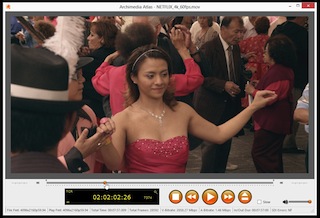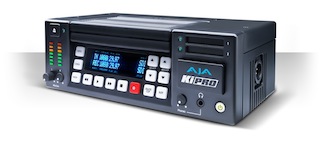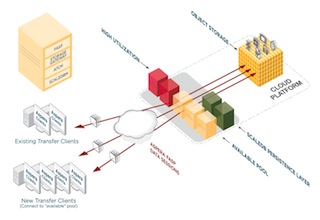 As the National Association of Broadcasters convention approaches, one topic that seems likely to get a lot of attention is the Interoperable Master Format. The motion picture industry as a whole is starting to coalesce around the concept of relying completely on metadata to carry content through the entire production, post-production and delivery process. In particular, the IMF is steadily gaining traction and, when widely adopted, could serve to streamline workflow and delivery. It can’t happen too soon.
As the National Association of Broadcasters convention approaches, one topic that seems likely to get a lot of attention is the Interoperable Master Format. The motion picture industry as a whole is starting to coalesce around the concept of relying completely on metadata to carry content through the entire production, post-production and delivery process. In particular, the IMF is steadily gaining traction and, when widely adopted, could serve to streamline workflow and delivery. It can’t happen too soon.
Josef Marc, co-founder and chief marketing officer for Archimedia said, “Producers and filmmakers are familiar with the technical attributes of the media produced on sets with cameras, and in effects generation, and sometimes in color correction. By comparison to deliverables, e.g., Netflix, iTunes, Hulu, Comcast, CBS Worldwide Distribution etc., the technical metadata in those deliverables goes into much more detail because of the need for automation. Producers and filmmakers typically order deliverables in the formats they know from production, and trust their mastering and post houses to deal with the rest. The AMWA AS-11 DPP format in the U.K., and the SMPTE IMF format, and the SMPTE committee revising timecode standards, and SMPTE Timed Text are all aimed at making an easier bridge and consistent lexicon between production, mastering, post and distribution.”
The Digital Cinema Package addressed many, if not most of these issues. But, over time, DCPs have sometimes created as many problems as they’ve solved.
Michael Karagosian, founder and president of MKPE Consulting, was part of the original technical group that developed the DCP concept more than a decade ago. Today, he’s among the most vocal in the industry calling for change.
“Here’s the problem in a nutshell,” Karagosian said. “With the transition to digital cinema, we established a uniform baseline of new technology around the world. At the distribution level, the uniform baseline is Interop DCP, not SMPTE DCP. (SMPTE DCP was not introduced until mid-rollout.) Besides wanting to move to SMPTE DCP, we also have multiple audio formats to deal with, and multiple image formats. The uniformity of installations is now devolving, which is a natural event, but one we didn’t consider. The number of content versions for a major release that a content distributor must now manage is in the hundreds. If they were to add SMPTE DCP to the mix, the number literally doubles. If it doubled and led to a return on investment, then SMPTE DCP would be more interesting. But SMPTE DCP will subtract from ROI, hence the resistance. What we’re missing is a way to gracefully move into newer technologies without significantly adding to the cost of content management for distributors. That’s what we didn’t consider in 2001, and what I’m proposing today.”
“The great question,” Karagosian continued, “is why we didn't standardize Interop DCP, since it was the version in use in the field? In hindsight, a lot of smart people – including me – thought that the final SMPTE DCP was just around the corner, and it wouldn't be a big deal to upgrade a small number of systems to the final formalized format. However, digital cinema began rolling out in late 2005, and the standardized version wasn't released until 2009. Such is committee work. The rest is history.”
 The incredible size of deliverables today is a major issue for everyone in the industry. Vincent Maza, market segment manager, media & entertainment, Aspera said, “The biggest misunderstanding about deliverables is the sheer amount of data that must be distributed to numerous outlets. One study about motion pictures reported that many studios have to deliver over 600 different versions of video content in multiple formats, including cinema and seconds screens ranging from IMAX to the smallest devices. Delivering to second screens comes at a risk, as most filmmakers rely on main screen for revenue and if the picture is pirated or accessed by unauthorized individuals, this can compromise the investment to the point of a total loss. For the independent community of filmmakers, who intrinsically place an even greater value on their video content, the risk is even higher. This is why secured file delivery is essential.”
The incredible size of deliverables today is a major issue for everyone in the industry. Vincent Maza, market segment manager, media & entertainment, Aspera said, “The biggest misunderstanding about deliverables is the sheer amount of data that must be distributed to numerous outlets. One study about motion pictures reported that many studios have to deliver over 600 different versions of video content in multiple formats, including cinema and seconds screens ranging from IMAX to the smallest devices. Delivering to second screens comes at a risk, as most filmmakers rely on main screen for revenue and if the picture is pirated or accessed by unauthorized individuals, this can compromise the investment to the point of a total loss. For the independent community of filmmakers, who intrinsically place an even greater value on their video content, the risk is even higher. This is why secured file delivery is essential.”
Kevin McEntee of Netflix understands this as well as anyone. It is probably one reason Netflix has been and continues to be an advocate for IMF.
“IMF does a great job of managing the proliferation of assets that make up any one title,” said McEntee. “One IMF package can have video, several audio language tracks, and several subtitle tracks. IMF is inspired by DCP and there is nothing better for curing versionitis.”
However, he cautioned, “IMF adoption will be slow until IMF authoring tools are widely available.”
In the meantime, post houses are dealing with their customer’s content in seemingly as many different ways as there are post houses, formats and projects. In addition to the technical considerations, post houses also deal with a sensitive personal issue: their customers have varying degrees of understanding of the challenge of getting their projects from the camera and to the screen, regardless what size that screen is.
Given that situation, some of the people Digital Cinema Report spoke with, understandably, declined to address that issue for fear of possibly embarrassing customers and potential customers.
One who did was Sieg Heep, chief systems engineer at Modern VideoFilm in Los Angeles who said that the challenge of bandwidth is something that often comes into play. He said, “The size of files and the bandwidth required to send and receive these files in a timely manner is not always understood. Many remote locations simply don’t have the necessary bandwidth required. Additionally, the infrastructure required, the cost and lead-time required is not always realized.”
 He continued, “Modern VideoFilm has met these challenges. We have private fiber between many of our studio clients and 10Gb Internet service. When transferring files over the Internet, we utilize Signiant and Aspera’s core UDP acceleration with transport layer security (TLS), which vastly improves latency resulting in much higher data transfer speeds. Service uptime is ensured by a central UPS with a generator backup. Modern VideoFilm has made the capital and in-depth engineering investment to ensure our customers data is sent and received as fast as possible.”
He continued, “Modern VideoFilm has met these challenges. We have private fiber between many of our studio clients and 10Gb Internet service. When transferring files over the Internet, we utilize Signiant and Aspera’s core UDP acceleration with transport layer security (TLS), which vastly improves latency resulting in much higher data transfer speeds. Service uptime is ensured by a central UPS with a generator backup. Modern VideoFilm has made the capital and in-depth engineering investment to ensure our customers data is sent and received as fast as possible.”
Formats are a constant issue and post houses of all sizes have to constantly adapt.
Jack Reynolds, technical director of WorleyWorks in Brooklyn said, “Typically for finishing we prefer to work directly from files generated by the camera. Ideally these files are camera Raw. We like to perform debayering in house so we can ensure the quality of the material. Working with Raw files allows us to access color information that can otherwise be lost and gives our clients additional confidence in the material. Workflows and budgets don’t always allow for shooting Raw and in these cases we will request whatever files were recorded. Our finishing system allows unlimited real time on pretty much every preferred codec being recorded.”
“EXR 2, this format allows uncompressed, 32 bit float, multilayer video. All color information is retained from the source (camera, VFX, CG) and with VFX a couple of extra render passes can bake in the required info for deep compositing, which adds a lot more control over individual assets at the finishing stage,” Reynolds said.
Bill Baggelaar, senior vice president of technology, production & post-production technologies for Sony Pictures Entertainment approaches this from the perspective of someone who works for a major Hollywood studio.
 “Sony Pictures has digital format delivery requirements,” he said, “and these can vary depending on the original capture source, the line of business (i.e., TV versus theatrical), territory distribution rights, etc. But generally we accept a few different formats in each category in order to be flexible. We have a big push for 4K content, so with 4K/UHD the choices are a bit more narrow.”
“Sony Pictures has digital format delivery requirements,” he said, “and these can vary depending on the original capture source, the line of business (i.e., TV versus theatrical), territory distribution rights, etc. But generally we accept a few different formats in each category in order to be flexible. We have a big push for 4K content, so with 4K/UHD the choices are a bit more narrow.”
“IMF is quickly becoming our preferred mezzanine format for both 4K/UHD and HD projects,” said Baggelaar. “Just as DCPs have replaced print deliverables, IMF fills a need for maintaining a very high quality servicing source master, but at the same time, being portable. We have been working with many of our content partners to bring them up to speed on accepting IMF as their deliverable of choice, as well.”
Ray Shantz, Modern VideoFilm’s vice president of engineering, digital media services said, “We create deliverables to our customer’s specifications, which means we have to be flexible. We can accept all digital formats that our customers can provide to us, except 8-inch floppy disk. For original camera material, we receive Arri Raw, ProRes or H.264 wrapped in QuickTime, H.264 wrapped in mp4, and Red camera files.”
Bill Wolmack, Modern VideoFilm’s senior engineer, digital media services added, “For finished program material, SMPTE DCP is the worldwide standard for digital cinema delivery. For video, ProRes files have gained popularity because of the early influence of making iTunes deliverables. IMF packages are gaining in popularity with the studios, as a standard format for video adapted from the Digital Cinema Package standards. The Digital Production Partnership in the UK has specified a common file format used for delivering video programming to broadcasters in an entire region. In the meantime, H.264 and MPEG-2 transport streams have not gone away. Modern VideoFilm creates and delivers files in all of these formats.”
Manufacturers do their best to remain format agnostics and to develop products that enable producers and post houses to deal with all the confusion.
Bryce Button, product marketing manager, AJA Video Systems said, “We constantly strive not to introduce yet another proprietary format, but instead put a lot of effort into ensuring that any deliverable format can be read and worked with as widely as possible, whether you are talking raster, frame rate or codec support needs.”
 “On the acquisition side of our product lines, AJA products like Ki Pro and the 4K-capable Cion camera offer built in control for raster sizes and a stipulation of frame rate needs during the capture phase, enabling you to get closer to, or even match delivery demands from the outset.”
“On the acquisition side of our product lines, AJA products like Ki Pro and the 4K-capable Cion camera offer built in control for raster sizes and a stipulation of frame rate needs during the capture phase, enabling you to get closer to, or even match delivery demands from the outset.”
Button continued, “For post-production needs, our Kona and Io product lines are designed for broad compatibility with a wide range of post-production software packages, on Mac and Windows, supporting 4K/HD/SD formats. Our custom built drivers and plug-ins are integrated for use with editorial software from Apple, Adobe, Autodesk, Quantel and more.”
As for what new products to expect from AJA at NAB, Button said, “AJA as a policy does not discuss items we have in development, but we are always tracking future trends, and ensuring that our solutions will be there to support our customers workflow needs.”
 Aspera’s Maza said, “We are working with standard bodies to help mandate the delivery of files that can be fully approved by the recipient without problematic errors or delays. Most companies today do not have proven records to guarantee delivery of files, whether small or large. We have the new Auto-Scaler for Aspera On Demand, which automatically adjusts cloud resources to match fluctuating demand in transfer capacity, and FASPStream, an evolution of our transport protocol that can move growing files (such as video being captured) with all the security and performance that major studios and post houses in and out of Hollywood have come to rely on every day.
Aspera’s Maza said, “We are working with standard bodies to help mandate the delivery of files that can be fully approved by the recipient without problematic errors or delays. Most companies today do not have proven records to guarantee delivery of files, whether small or large. We have the new Auto-Scaler for Aspera On Demand, which automatically adjusts cloud resources to match fluctuating demand in transfer capacity, and FASPStream, an evolution of our transport protocol that can move growing files (such as video being captured) with all the security and performance that major studios and post houses in and out of Hollywood have come to rely on every day.
Archimedia’s Marc said, “To improve collaboration between producers, filmmakers, and their deliverables service providers, Archimedia is bringing a new product to NAB called Iris. Similar to the Atlas professional media player, Iris is a professional media collaboration platform, always frame-accurate. Proxy video and cloud processes are optional because some producers and filmmakers use them, and some don't.”
“SMPTE TC-35PM Media Packaging and Interchange is expressly designed to streamline the deliverables process,” he said, “and Archimedia has two people on that committee. Atlas and Iris read these files precisely in all their components, video, audio, titles, technical metadata, and descriptive metadata. Producers and filmmakers are particularly interested in the latter, descriptive metadata, because it's the link to their productions and content titles (copyrights).”
Marc said, “Formats were last decade's prime consideration, and they're still important. But the next decade's deliverables will be defined by metadata beyond what any self-contained media format can hold. In studios, this is called "component workflows" where video, audio, titles and descriptive metadata workflows run in parallel, so they can't be packed into monolithic file formats like ProRes QuickTime (MOV), MXF OP1a (broadcast standard) etc. That's why the industry now needs IMF, better timecode lexicons, and frame-accurate media tools like Iris that make the metadata conversation into a component workflow, too.”
